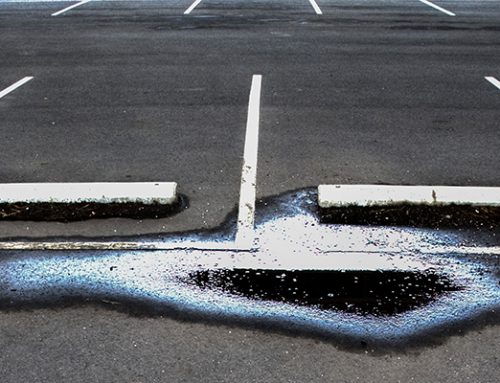For many customers, your parking lot is one of the first things they notice about your business. And a poorly maintained parking lot can lead to a negative first impression.
Professional contractors usually do parking lot striping – but understanding the process will help you get the best quality at a competitive price.
Why is Parking Lot Striping Important?
- It prevents collisions and improves traffic flow. Arrows for entrances, exits, and directional flow, along with clearly marked loading areas and fire lanes, help keep traffic moving smoothly and prevent vehicular accidents.
- It creates a safe surrounding for visitors and employees. When pedestrians can easily identify which pathways to use, they won’t unknowingly stand or walk in loading zones.
- It enables you to comply with ADA regulations. Since you are legally responsible if a person with a disability is injured on your non-compliant ADA property, you must meet the ADA Standards for Accessible Design.
- It improves curb appeal. A well-maintained and clean parking lot reflects your business and shows you take pride in your property. Bright paint on black asphalt provides clear directions for pedestrians and drivers and improves curb appeal.
- It maximizes the number of parking spaces in your lot. By carefully planning your line striping, you can accommodate more visitors into your lot and provide smooth and safe traffic flow.
Everything You Need to Know About Parking Lot Striping
Even though a professional contractor takes care of the parking lot striping, you probably want to understand how to determine the best layout for your property. Here are some basic parking lot design specifications and considerations.
Parking Stall Sizes and Angles
- A typical stall size is 9×18 feet. A compact stall is typically 7.5×15 feet or 8.5×16 feet, and an accessible stall must be at least 8 feet wide. Before determining stall sizes, consult the zoning requirements in your area.
- There are three types of angles used in parking spaces:
1. straight-in parking at 90°
2. angle parking with lines that are between 45° and 60°
3. parallel spaces with 90° angles but are parallel to a border with perpendicular lines
- If there is a lot of turnover in the parking lot, use 45° to 60° angles.
- It’s more difficult to park in a space with a 90° angle, so only use this layout for full-day or overnight parking.
Lines and Paint
- Lines are four inches wide and between 15 and 18 feet long.
- Latex is the most used paint, but it’s only approved in certain states. Oil-based paint is typically used for new layouts and re-striping.
- Lines are 15 mils thick (one mil = 1/1000 of an inch) requiring two coats of paint.
- Many lines and marking colors are up to you, but most people choose white or yellow lot stripes. Some lines, like loading, fire, and handicapped zones, require specific colors to meet the regulations.
ADA Parking
ADA regulations stipulate that all signage must be on the pavement and upright signs. Check the U.S. Access Board’s website for a complete list of how many accessible spaces you need for the number of parking spaces in your lot.
Read More: A Simple Guide to Parking Lot Striping
How to Prepare Your Lot for Line Striping
You can save time and money by ensuring your lot is ready for line striping. Follow these helpful tips:
1. Inspect your lot. New lines won’t last if you’re painting over damaged pavement, so have repairs done before striping.
2. Inform visitors and employees in advance. If a crew is striping during business hours, plan for alternative parking spaces for visitors and employees.
3. Clean your parking lot. Remove dirt and debris so the paint will bond better and last longer.
4. Give it time to dry completely. If you cleaned it with water, make sure it has plenty of time to dry before the crew arrives. Turn off any sprinkler systems for adjacent landscaping.
How Much Does Parking Lot Striping Cost?
The cost of parking lot striping depends on a few things. A new parking lot that must be designed and measured usually costs more than re-striping over existing lines. Contact an experienced asphalt contractor to get an exact estimate, but here are some things that can add to the cost:
- Parking lot square footage and the number of linear feet of parking spaces
- The number of other markings can add to the cost – stop signs, crosswalks, handicap spaces, fire lanes, loading zones, arrows, and speed bumps
- Extra items that require additional paint
- Line thickness
Hire a Professional Company like Premium Asphalt Paving & Sealcoating
Parking lot striping and maintenance is a must for every commercial property or business – no matter the size! A professional company has the experience and access to the resources and materials necessary to stripe parking lots.
At Premium Asphalt Paving & Sealcoating, we understand that time is of the essence! The sooner we complete your asphalt parking lot job, the sooner you can get on with your business. That’s why we offer some of the most efficient parking lot services in College Station and surrounding areas. Contact us today for a free estimate.







